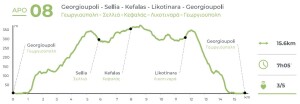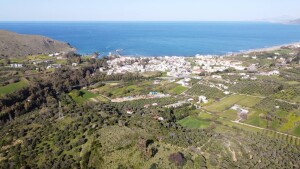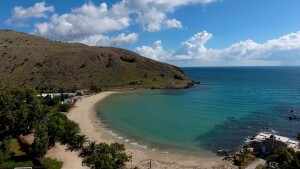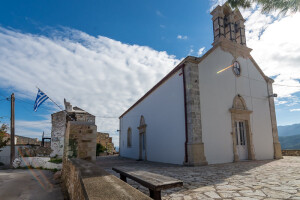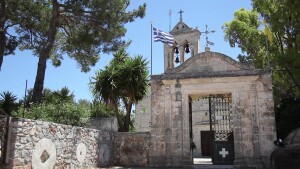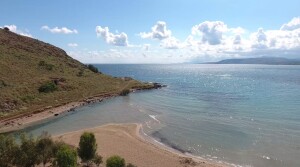Paths of Apokoronas (Route 8)
Route 8: Contrasting landscapes
Georgioupolis - Argyromouri - Agios Dimitrios (Katouna) - Sellia - Kefalas - Roupakias Forest - Likotinara - Agia Kyriaki - Georgioupolis
Total length: 15.6 km, estimated time 7h 05΄
Part A: 7.7 km, estimated time 3h 40΄
Georgioupolis - Argyromouri - Agios Dimitrios (Katouna) - Sellia - Kefalas
Route 8 starts from Georgioupolis, a seaside town built by the Gulf of Almyros, next to the point where the river with the same name meets the sea. The city was named after Prince George of Greece, High Commissioner of Crete during the period 1898-1906. Apart from the long sandy beaches that extend eastwards all the way to Petres River, some other remarkable points of interest are the church of Ag. Nikolaos, built on a small island that was later connected with a pier to the mainland, and the bridge over Almyros River, to the northeast of which you will find Kalyvaki beach. At the north end of this beach there is another bridge over the mouth of the river Vlychada, to the east of which you can visit the picturesque church of Agia Kyriaki and a bunker built during the German occupation (1941-1945) in order to control the entrance of the port of Georgioupolis. From the bridge of Vlychada the path moves west -and uphill- to Argyromouri (1.1 km), passing by a lime kiln and some places with great views to the sea. Arriving at Argyromouri, make a short stop at the church of Agios Georgios and continue to Exopoli (600 meters), in order to admire its old houses and visit the church of the Assumption of the Virgin and Agios Dimitrios, which has the extremely rare characteristic that it has one aisle and one dome, but two sanctuary niches. Then continue north to Agios Dimitrios - Katouna (700 meters), from where an uphill path leads you to Sellia (2.2 km).
Sellia has probably taken its name from the plural of the Cretan word “selli”, which means “mountain pass”. The houses of the settlement are scattered, but many are excellent examples of folk architecture, while some have been repaired and are maintained in good condition. The church of the village is dedicated to Agio Pnevma (the Holy Spirit) and was built in the early 19th century, while further south the road leads to the Ganade hill, where the Ottomans built a tower and the Germans dug an underground shelter. About 260 meters after the junction where the old café of the village used to be, turn left (north) and again right (northeast) at the first fork after 200 meters, following a path that crosses the eastern part of the Roupakias Forest.
About 900 meters away, the path gradually widens to a dirt road, but after 150 meters turn right (north), following a path that ends 400 meters away at a paved road to Kefalas, one of the largest and most important villages of Municipal Unit of Vamos. Here it is worth walking through the old alleys of the village and visiting some of its many churches, the oldest of which is Timios Stavros (the Holy Cross), built in the 16th century. Some of the newer churches are also of particular interest, as in the case of Panagia, Agios Antonios and Michael Archangelos, exquisite examples of local religious architecture of the 18th and 19th centuries. The same local craftsmen built the Primary School of Kefalas, which today houses the Center for Environmental Education of Vamos, next to which you can find a small folklore museum, which exhibits samples of textile art and household utensils and tools of bygone eras.
From Kefalas you can return by road to Georgioupolis (10 km) or “refuel” and continue to Part B of this route, with the same destination.
Part B: 7.4 km, estimated time 3h 25΄
Kefalas - Roupakias Forest - Likotinara - Agia Kyriaki - Georgioupolis
Part B of Route 8 is as interesting as A, but it has the additional advantage that many parts of it overlook the Gulf of Almyros to the east of Apokoronas. From the main square of Kato (Lower) Kefalas head to Ano Kefalas (Upper), where you will find many old houses and churches. During the Venetian occupation, Ano and Kato Kefalas were two distinct villages, which became one over time (administratively by the mid-20th century). About 190 meters to the southeast you will find the church of Archangelos Michail, an excellent example of 18th century folk architecture. Continue south on the same road, turn left at its end and right (southwest) at the next junction.
A little further away the road becomes a dirt road, on which you will continue for another 400 meters. Near its end, turn left (south) at the marked path, which leads to the eastern end of the Roupakias Forest 500 meters away. Cross the next dirt road vertically and continue on the same path, which broadens into a dirt road as you ascend. You should see a vineyard on your right (west) and after a while you will reach the road that connects Sellia to Likotinara. From here, you can continue right (west) to Sellia and return again to Kefalas, or continue to Georgioupolis (see Part A) or turn left (east) and reach Likotinara after 500 meters.
Likotinara is built at an altitude of 290 meters at the eastern end of the Vamos hills, just south of (or opposite) the Kefalas hills. Due to its location, the village has excellent views to the Gulf of Almyros, and on a clear day you can see much of the provinces of Rethymno and Mylopotamos, as well as Kouloukonas (Mount Talos of antiquity) and Psiloritis (Mount Ida). The slope below the village has several palm trees, which have given the site the name Vayonia. Locals do not know how these tropical trees grew there, but it is likely that their seeds were transported by migratory birds which pass through this area every year, traveling from and to Africa. The area east of the village is known as “Gremna” (cliffs) and is a protected ecosystem under the Natura 2000 Network, at the boundaries of which you will continue moving south. From the view point turn back (north) for 40 meters and then turn left (west) on the uphill road to the highest houses. Turn left at the next junction after 400 meters and continue south on the same dirt road along the ridge of the hills, turning right (southwest) at the lime kiln you will encounter after 600 meters. Here the dirt road becomes a path that descends sharply, offering excellent views of the Gulf of Almyros and the coast east of Georgioupolis.
About 1.1 km below you will reach Argyromouri (again), from where you can follow the same path you climbed from Vlychada bridge and get to Kalyvaki beach and the center of Georgioupolis.
Source: Municipality of Apokoronas (2022)










